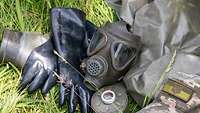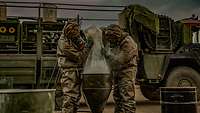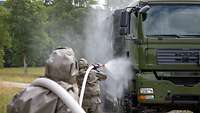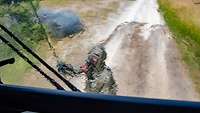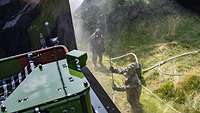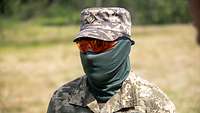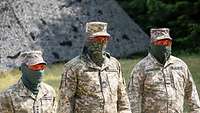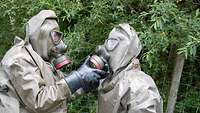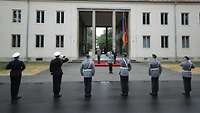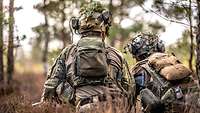The Bundeswehr trains Ukrainian military personnel in CBRNchemical, biological, radiological, nuclear defence
The Bundeswehr trains Ukrainian military personnel in CBRNchemical, biological, radiological, nuclear defence
- Date:
- Place:
- Strausberg
- Reading time:
- 5 MIN
How are decontamination of trucks, the nuclear power plant in Zaporizhzhia, the rupture of the Kakhovka dam and the EUMAMEuropean Union Military Assistance Mission training mission for Ukrainian armed forces related? Captain Yevhen, a serviceman from Ukraine, gives the answer.
The officer is commanding a group of almost three dozen Ukrainian military personnel who are with the EUMAMEuropean Union Military Assistance Mission training mission for three weeks. They are learning from Bundeswehr military personnel how to deal with the effects of nuclear, biological or chemical agents. “If you consider that we are currently fighting a war against an aggressor state, you can’t rule out the possibility of use of tactical nuclear weapons or an attack on a nuclear power plant”, the Ukrainian officer says. “Experience has shown that Russia doesn’t hesitate to destroy a dam and cause a natural disaster”, Captain Yevhen continues, explaining the need for this special training. Germany’s CBRNchemical, biological, radiological, nuclear defence capabilities are part of the Joint Support and Enabling Service’s portfolio and considered some of the best in the world. Germany has handed over six special CBRNchemical, biological, radiological, nuclear defence vehicles to Ukraine. The training is conducted with these vehicles, known as HEP 70 (main decontamination point 70). With its two 1,500-litre tanks, the HEP 70 is used to decontaminate vehicles that have been contaminated with nuclear, biological or chemical substances.
Day and night training
We meet the Ukrainians at the end of the training period. In a three-day exercise at the end of the training, they are to demonstrate their proficiency. It is hot in the south of Bavaria on these summer days – the temperature is 30 degrees Celsius even in the shade. At night, temperatures cool down a little. But, even then, it is not time for the Ukrainians to rest because the exercise continues at night. “From seven p.m. tonight, we will prepare an emulsion. After that, we will start decontamination. I think we should be done by around three in the morning”, Lieutenant Franz W. explains what will happen in the next few hours. “Night training is an excellent instrument as, in the dark, every move has got to be perfect".
Day or night, there is no difference in the training contents. The Ukrainian service members set up forward decontamination stations both in the dark and during daylight. The Ukrainian military personnel are focused on their task. It starts with reconnaissance activities in the area of operations – this time, it is a gravel road in hilly terrain. Captain Yevhen quickly determines where to set up the sites for pre-treatment, main treatment and post-treatment. “Our instructors have also taught us the tactical aspects that need to be considered. That is why two of the vehicles are positioned next to slopes and the third near the edge of a forest, so that they can’t be detected as easily”, explains Yevhen.
Decontamination helps protect against lethal substances
The first vehicle is already driving up the slope to the decontamination station. It looks a bit like an off-road car wash. Two Ukrainian personnel in CBRNchemical, biological, radiological, nuclear protective suits rush towards the trucks to hose them down thoroughly with water. The third member of the HEP crew is standing on the vehicle and operating the system. In the burning sun, water vapour rises from the vehicle. The Ukrainians are wearing boots, two pairs of gloves, CBRNchemical, biological, radiological, nuclear masks and the Zodiak protective suits – it must be dreadfully hot in this gear. However, in a real emergency, this protection would be vital because some chemical or biological agents can be lethal even through skin contact.
The underbody and the roof of the vehicle are also carefully cleaned. “This is going really well”, says the German instructor, assessing their work. “They are working L-wise on the truck: one person is working on the front and the right side of the truck, and the other one is working on the left side and the rear. Just as we taught them”. Each step in the treatment is performed within five minutes; after the main treatment, the emulsion has to stay on for some time. “We prepare the appropriate emulsion depending on the type of contamination. This time, according to the exercise scenario, a chemical agent has been used. That is why we leave the solution on for 15 minutes. This is how we learned it from the instructors”, Captain Yevhen reports. After a little more than half an hour, the first of three vehicles is completely decontaminated.
Translated to the war in Ukraine, this would mean that the vehicle and its crew could be employed again to counter Russian attacks. After all, this is what CBRNchemical, biological, radiological, nuclear defence is about: restoring the combat effectiveness of vehicles despite their exposure to CBRNchemical, biological, radiological, nuclear agents.
Ready for an emergency
The commander of 750 CBRNchemical, biological, radiological, nuclear Defence Battalion “Baden”, whose men and women conducted the training, is also observing the final exercise. “During the first two weeks, the Ukrainian service members received training in different areas that are essential for the use of the HEP 70: driving, decontaminating and repairing vehicles and materiel”, explains Lieutenant Colonel Daniel Razat. “Our trainees are highly motivated military personnel who did not call it a day after eight hours of work but continued to learn and practise every day and until late in the evening”. He is convinced that the training is a success: “You can tell by the results of this final exercise".
Do the Ukrainians share this view? “Yes”, Captain Yevhen says. “We have learned the techniques and tactics of CBRNchemical, biological, radiological, nuclear defence. We are ready. But I hope that we never have to use them".


